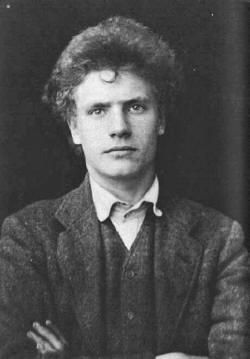Queer Places:
St. Mary's Churchyard
Ilford, London Borough of Redbridge, Greater London, England
 Austin
Osman Spare (30 December 1886 – 15 May 1956) was an
English artist and
occultist[1][2]
who worked as both a draughtsman and a painter. Influenced by
symbolism and
art nouveau his art was known for its clear use of line,[3]
and its depiction of monstrous and sexual imagery.[4]
Spare's major patron during this period was the wealthy property developer
Pickford Waller, although other admirers included
Desmond Coke,
Ralph Strauss,
Thomas Scott-Ellis, 8th Baron Howard de Walden and
Charles Ricketts.[23]
Spare became popular among avant-garde
homosexual circles in Edwardian London, with several known gay men
becoming patrons of his work.[35]
In particular he became good friends with the same-sex couple
Marc-André Raffalovich and
John Gray, with Spare later characterising the latter as "the most
wonderful man I have ever met."[36]
Gray would introduce Spare to the Irish novelist
George Moore, whom he would subsequently befriend.[37]
The actual nature of Spare's sexuality at the time remains debated; his friend
Frank Brangwyn would later claim that he was "strongly" homosexual but had
suppressed these leanings.[38]
In contrast to this, in later life Spare would refer to a wide variety of
heterosexual encounters that took place at this time, including with a
hermaphrodite, a
dwarf
with a protuberant forehead and a Welsh maid.[39]
He would unsuccessfully also attempt to woo both Sybil Waller, the daughter of
Pickford Waller, as well as a younger girl named Constance "Connie" Smith.[40]
Austin
Osman Spare (30 December 1886 – 15 May 1956) was an
English artist and
occultist[1][2]
who worked as both a draughtsman and a painter. Influenced by
symbolism and
art nouveau his art was known for its clear use of line,[3]
and its depiction of monstrous and sexual imagery.[4]
Spare's major patron during this period was the wealthy property developer
Pickford Waller, although other admirers included
Desmond Coke,
Ralph Strauss,
Thomas Scott-Ellis, 8th Baron Howard de Walden and
Charles Ricketts.[23]
Spare became popular among avant-garde
homosexual circles in Edwardian London, with several known gay men
becoming patrons of his work.[35]
In particular he became good friends with the same-sex couple
Marc-André Raffalovich and
John Gray, with Spare later characterising the latter as "the most
wonderful man I have ever met."[36]
Gray would introduce Spare to the Irish novelist
George Moore, whom he would subsequently befriend.[37]
The actual nature of Spare's sexuality at the time remains debated; his friend
Frank Brangwyn would later claim that he was "strongly" homosexual but had
suppressed these leanings.[38]
In contrast to this, in later life Spare would refer to a wide variety of
heterosexual encounters that took place at this time, including with a
hermaphrodite, a
dwarf
with a protuberant forehead and a Welsh maid.[39]
He would unsuccessfully also attempt to woo both Sybil Waller, the daughter of
Pickford Waller, as well as a younger girl named Constance "Connie" Smith.[40]
In an occult capacity, Spare developed idiosyncratic magical techniques
including
automatic writing,
automatic drawing and
sigilization based on his theories of the relationship between the
conscious and unconscious self.
Born into a working-class family in
Snow Hill in London, Spare grew up in
Smithfield and then
Kennington, taking an early interest in art. Gaining a scholarship to
study at the
Royal College of Art in
South Kensington, he trained as a draughtsman, while also taking a
personal interest in
Theosophy and
Occultism, becoming briefly involved with
Aleister Crowley and his
A∴A∴. Developing
his own personal occult philosophy, he authored a series of occult
grimoires,
namely
Earth Inferno (1905),
The Book of Pleasure (1913) and
The Focus of Life (1921). Alongside a string of personal exhibitions,
he also achieved much press attention for being the youngest entrant at the
1904
Royal Academy summer exhibition.
After publishing two short-lived art magazines, Form and The
Golden Hind, during the
First World War he was conscripted into the armed forces and worked as an
official war artist. Moving to various working class areas of South London
over the following decades, Spare lived in poverty, but continued exhibiting
his work to varying success. With the arrival of
surrealism onto the London art scene during the 1930s, critics and the
press once more took an interest in his work, seeing it as an early precursor
to surrealist imagery. Losing his home during the
Blitz,
he fell into relative obscurity following the
Second World War,, although he continued exhibiting till his death in 1956.
Spare's spiritualist legacy was largely maintained by his friend, the
Thelemite
author
Kenneth Grant in the latter part of the 20th century, and his beliefs
regarding sigils provided a key influence on the
chaos
magic movement and
Thee Temple ov Psychick Youth. Spare's art once more began to receive
attention in the 1970s, due to a renewed interest in art nouveau in
Britain, with several retrospective exhibitions being held in London. Various
books have been written about Spare and his art by the likes of Robert Ansell
(2005) and Phil Baker (2011).
In failing health, in May 1956 he was submitted to the
South Western Hospital in Stockwell with a burst appendix; the doctor
noted that he had also been suffering from
anaemia,
bronchitis,
high blood pressure and
gall stones. Rushing to see him at his hospital bed, it was here that
Spare's two dearest friends, Kenneth Grant and
Frank Letchford, met one
another for the first time. Spare died on the afternoon of 15 May 1956, at the
age of 69.[96]
In his will, Spare left Letchford his first choice of 15 pictures, with Grant
getting the second choice of 10 others, along with all of his books and
papers. His funeral was paid for by his friend
Hannen Swaffer, and he was
buried alongside his father at St. Mary's Church in
Ilford.[96]
My published books:


BACK TO HOME PAGE

- https://en.wikipedia.org/wiki/Austin_Osman_Spare
 Austin
Osman Spare (30 December 1886 – 15 May 1956) was an
English artist and
occultist[1][2]
who worked as both a draughtsman and a painter. Influenced by
symbolism and
art nouveau his art was known for its clear use of line,[3]
and its depiction of monstrous and sexual imagery.[4]
Spare's major patron during this period was the wealthy property developer
Pickford Waller, although other admirers included
Desmond Coke,
Ralph Strauss,
Thomas Scott-Ellis, 8th Baron Howard de Walden and
Charles Ricketts.[23]
Spare became popular among avant-garde
homosexual circles in Edwardian London, with several known gay men
becoming patrons of his work.[35]
In particular he became good friends with the same-sex couple
Marc-André Raffalovich and
John Gray, with Spare later characterising the latter as "the most
wonderful man I have ever met."[36]
Gray would introduce Spare to the Irish novelist
George Moore, whom he would subsequently befriend.[37]
The actual nature of Spare's sexuality at the time remains debated; his friend
Frank Brangwyn would later claim that he was "strongly" homosexual but had
suppressed these leanings.[38]
In contrast to this, in later life Spare would refer to a wide variety of
heterosexual encounters that took place at this time, including with a
hermaphrodite, a
dwarf
with a protuberant forehead and a Welsh maid.[39]
He would unsuccessfully also attempt to woo both Sybil Waller, the daughter of
Pickford Waller, as well as a younger girl named Constance "Connie" Smith.[40]
Austin
Osman Spare (30 December 1886 – 15 May 1956) was an
English artist and
occultist[1][2]
who worked as both a draughtsman and a painter. Influenced by
symbolism and
art nouveau his art was known for its clear use of line,[3]
and its depiction of monstrous and sexual imagery.[4]
Spare's major patron during this period was the wealthy property developer
Pickford Waller, although other admirers included
Desmond Coke,
Ralph Strauss,
Thomas Scott-Ellis, 8th Baron Howard de Walden and
Charles Ricketts.[23]
Spare became popular among avant-garde
homosexual circles in Edwardian London, with several known gay men
becoming patrons of his work.[35]
In particular he became good friends with the same-sex couple
Marc-André Raffalovich and
John Gray, with Spare later characterising the latter as "the most
wonderful man I have ever met."[36]
Gray would introduce Spare to the Irish novelist
George Moore, whom he would subsequently befriend.[37]
The actual nature of Spare's sexuality at the time remains debated; his friend
Frank Brangwyn would later claim that he was "strongly" homosexual but had
suppressed these leanings.[38]
In contrast to this, in later life Spare would refer to a wide variety of
heterosexual encounters that took place at this time, including with a
hermaphrodite, a
dwarf
with a protuberant forehead and a Welsh maid.[39]
He would unsuccessfully also attempt to woo both Sybil Waller, the daughter of
Pickford Waller, as well as a younger girl named Constance "Connie" Smith.[40]
